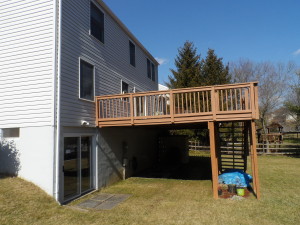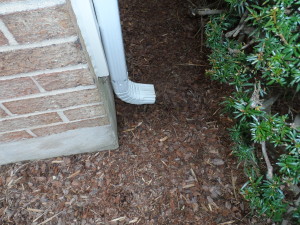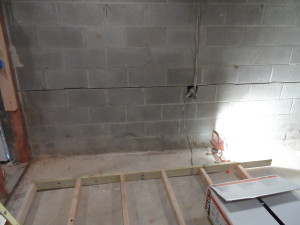At Kemp Home Inspections, LLC, we do dozens of structural home inspections each month and in most cases, the cause of foundation problems is so laughably avoidable that I felt it was time to assist homeowners of the world and offer some advice now before your foundation is damaged. In case you didn’t know, the foundation is the single most important and expensive part of your home.
So here it is. Kemp Home Inspections Top 4 Ways to Protect your Foundation.

The back yard for this property is too flat. Water can puddle near the foundation. Improve grading (more slope) for better drainage.
1. Grading. Make sure the ground slopes away from your foundation. It helps to keep water away. Water can really mess up your foundation. Ideally the ground should slope about 1 inch per foot for five feet, but this is not always easy to achieve so do the best you can. To be sure things are peachy, walk around the property immediately after a good rain and see if any water pools near your foundation. Check again one day after rain. Are there wet spots? If drainage is insufficient get a landscaper (or a shovel) and make things right.

This roof dumps water right next to the foundation. You should extend gutter downspout to make sure water moves away from the foundation.
2. Gutters and Downspouts. The gutters catch the water along the eve of the roof. The downspouts bring the water from the gutters to the ground. Downspout extensions take water away from the foundation. Make sure the system works to move water away from the house. Gutters should be clean (no leaves). Downspouts should be open and free flowing. Water should move at least 5 feet from the foundation. And don’t use those plastic splash blocks under your downspouts. A strong wind will blow them sideways. And all too often I see splash blocks (both plastic and concrete) installed backward preventing the water from flowing away.
3. Trees. Trees near your foundation are bad. Especially big trees. Big tree have big roots. Big roots are strong and can push on foundation walls and damage them. Too often I see horizontal cracks caused by this. If you take corrective actions quickly, you can save yourself from expensive repairs because a moderate-sized horizontal crack may require substantial reinforcement and repairs. Also, cut back plants or vines that are up against your home so they don’t hinder air circulation and trap moisture.

This is the type of crack that can come from excessive tree roots pushing against the foundation. (Sometimes water can also do this.) It is important to address cracks like this early, before they become costly to repair.
4. Monitor cracks. If you have cracks in your foundation, there is no need to panic. Most foundation cracks are nothing to worry about, especially when they are small (say, pencil width or less). But if you find new cracks, or cracks that are changing, it’s worth calling a qualified inspector to make an assessment. The problem when buying a home is you generally don’t know how old the crack is, so getting the opinion of a professional engineer may be prudent.
